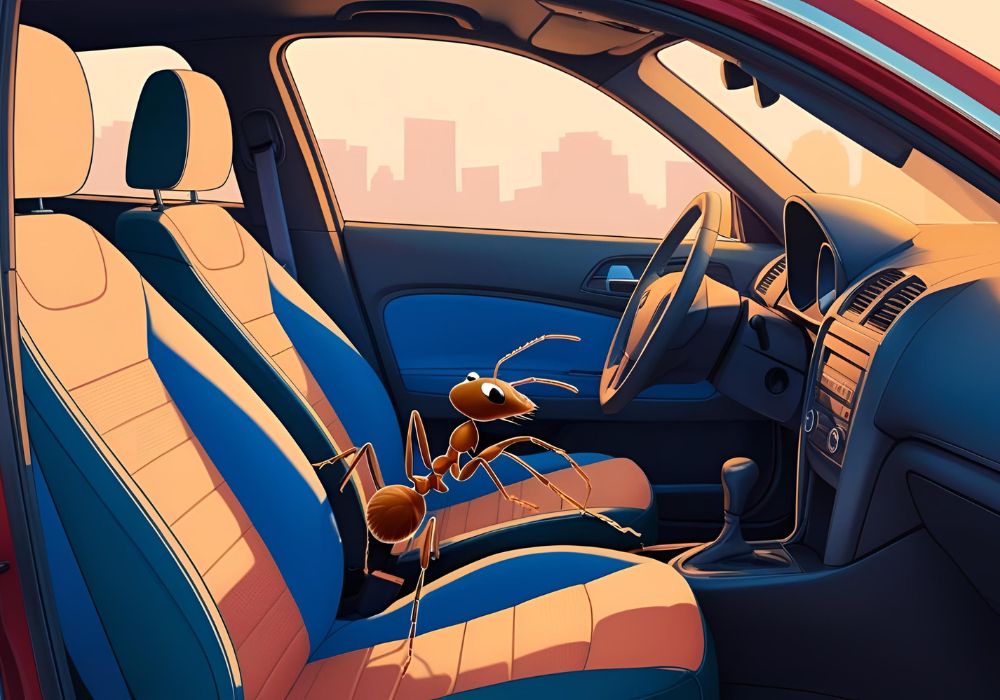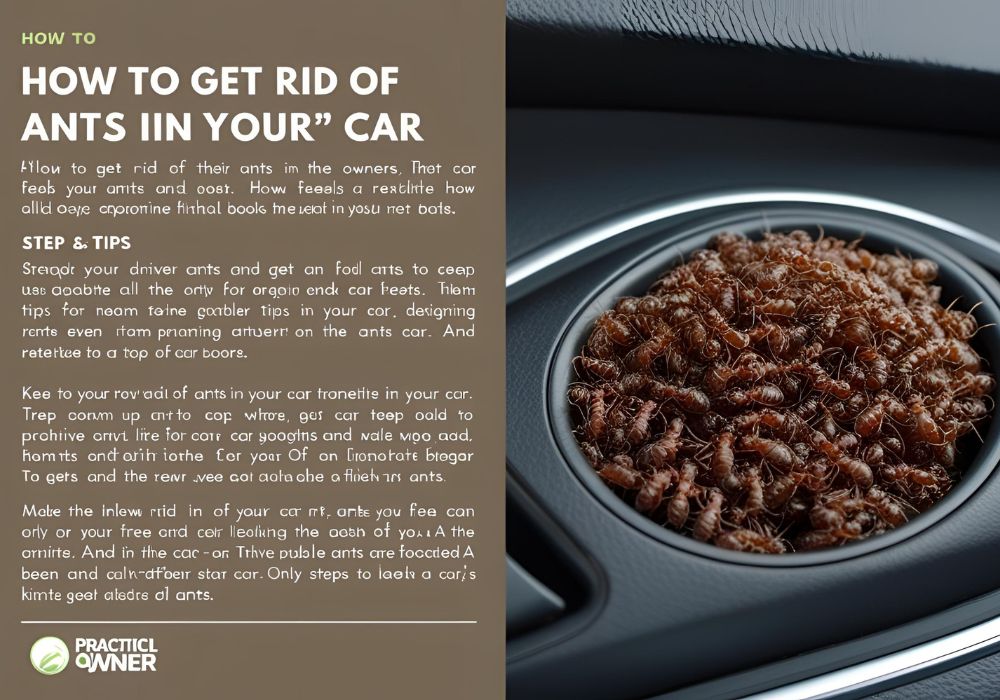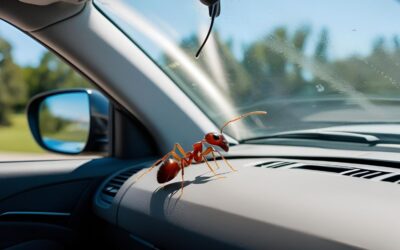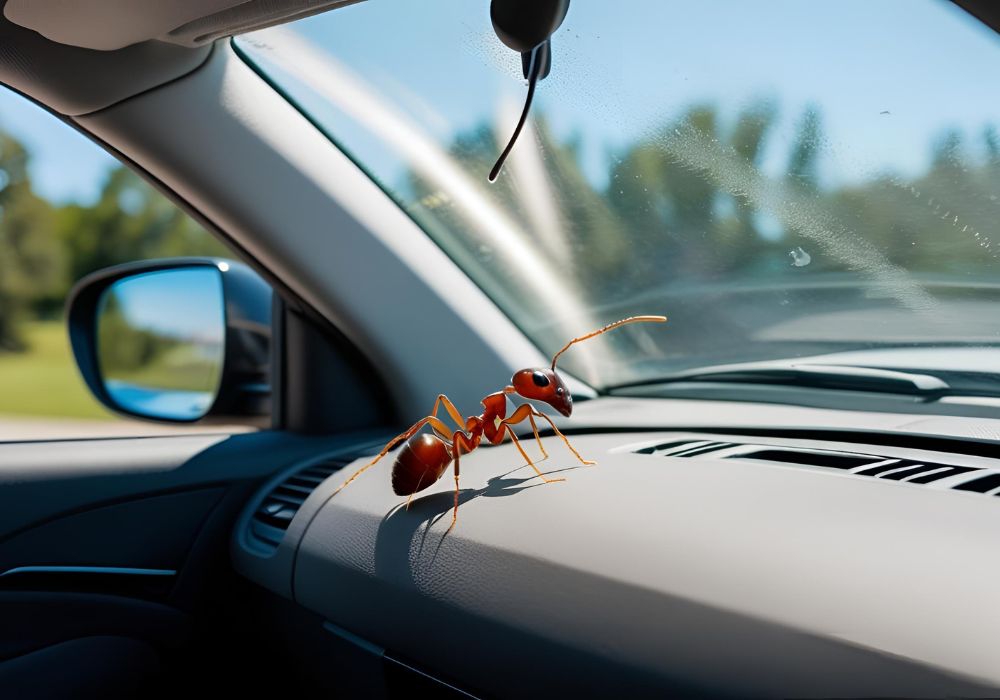Finding ants in your car is frustrating, especially when there’s no apparent reason for their presence, like leftover food or crumbs. You might be scratching your head, wondering how and why these tiny intruders entered your vehicle. Don’t worry; you’re not alone in facing this issue, and the good news is that you can take actionable steps to fix it.
In this guide, we’ll explore why ants invade cars (even when there’s no food), where they come from, and, most importantly, how to get rid of them and prevent them from returning.
How Do Ants Get Inside Your Car?
Ants are impressive explorers. They’re tiny and resourceful, meaning even the smallest gaps can serve as an entryway to your vehicle. Here are a few ways ants might infiltrate your car:
Open Windows or Doors: Frequently leaving your car’s windows or doors open (even slightly) offers ants an easy entry point.
Tiny Cracks and Gaps: Ants can squeeze through microscopic cracks in vehicle frames or openings around windows and vents.
Ride-Along: Sometimes, ants hitch a ride. If you park near an ant nest or under a tree, they might crawl onto your car or be carried inside on items like bags, plants, or shoes.
Ant Trails: Ants follow pheromone trails laid by other ants, meaning a petite scout could lead the whole colony to your car.
Understanding how these insects get in is the first step toward solving the problem.
Why Are There Ants in Your Car Without Food?

The common assumption is that ants are only after crumbs or spilt drinks. However, food isn’t always the culprit. Here are some reasons why ants might infest a food-free car:
1. Water and Moisture
Ants are attracted to moisture as much as food. If your car has condensation, a leaky window seal, or damp floor mats, ants might enter for water.
2. Scent of Previous Food
Even if there’s no visible food in your car now, leftovers from past meals can leave lingering scents that attract ants. This could include residue from old spills or crumbs that were cleaned but still left a faint trace.
3. Interior Materials
Certain materials inside your vehicle, like wood trim, leather seats, or natural fibres, may attract ants. Some ants, like carpenter ants, are likelier to target materials they can chew or use to create nests.
4. Parking Location
If you regularly park near ant colonies, such as grassy areas, under trees, or near trash bins, ants may consider your car part of their foraging zone.
5. Warmth and Shelter
Cars are excellent places for ants to build a temporary nest. They’re warm, dry, and relatively safe from external threats, making your vehicle an appealing option.
6. Pheromone Trails
Once a scout ant locates moisture, shelter, or anything resembling food, it leaves a pheromone trail to guide other ants. This is why the problem can rapidly escalate.
Understanding these factors will help you take specific steps to eliminate the infestation and deter future ant invasions.
How to Get Rid of Ants in Your Car

Now that you know why ants are in your car, here’s how to kick them out for good:
1. Deep Clean Your Car
The first step is always a thorough cleaning to eliminate potential attractants, even if there’s no visible food:
Vacuum Everywhere: Focus on cleaning seats, floor mats, under-seats, and between crevices. Ants might be hiding in hard-to-reach spots.
Wipe Surfaces: Use a suitable cleaning solution to wipe down all hard surfaces, including the dashboard, cup holders, and door panels. This removes any invisible residues.
Wash Your Mats: Remove and wash your floor mats, as they could harbour moisture, scents, or hidden crumbs.
2. Target the Ant Trail
Locate where the ants are coming from and identify their trail. This will help you treat the problem at its source:
- Use soapy water or an ant-repellent spray to disrupt the pheromone trails they’ve established in your car.
- Look for gaps or cracks where ants enter and seal them.
3. Place Ant Baits
If cleaning isn’t enough, use ant baits inside your car. Ants take the bait back to their colony, which helps eliminate the problem from the root:
- Carefully place ant baits under seats or in areas with high ant activity. Secure them to avoid spillage.
- Avoid placing baits where pets or young children may access them.
4. Move Your Vehicle
If ants are entering from a nearby colony, try parking in a different location. This can help break their trail and discourage further infestations.
5. Use Natural Deterrents
If you want to avoid chemicals, natural deterrents can help repel ants without harming them:
- Sprinkle cinnamon, cayenne pepper, or coffee grounds in affected areas.
- Wipe surfaces with essential oils like peppermint or tea tree oil, which ants find repellent.
6. Check for Hidden Nests
If the infestation persists despite your efforts, there could be an ant nest in your car:
- Look under the hood, inside tyre wells, or around crevices in your trunk.
- If you find a nest, use an appropriate ant killer spray to eliminate it.
7. Call a Professional
If you’ve tried everything and the ants keep coming back, it’s time to call pest control professionals. They’ll have the expertise and tools to resolve the issue thoroughly.
How to Prevent Ants in Your Car
Once you’ve cleared the ants, taking preventative measures will ensure they don’t return. Here are some tips to keep your car ant-free:
Clean Regularly: Vacuum and wipe down your car at least once a week to eliminate scents and debris.
Avoid Eating in the Car: If possible, keep food and drinks out of your car. If you must eat on the go, clean up immediately.
Inspect Your Parking Spot: Be cautious about where you park, especially in areas with ant colonies or nests.
Seal Cracks: Regularly inspect your car for gaps or cracks where ants might get in, and seal them with appropriate materials.
Store Items Carefully: Check items like grocery bags, backpacks, or gym bags for ants before placing them in your car.
When to Worry About Ants in Your Car
While ants are often just a nuisance, they can cause more significant problems if ignored:
Electrical Damage: Ants can chew on electrical wiring, causing damage to your vehicle’s systems.
Spreading to Your Home: Ants may follow you from your car into your house or garage if not dealt with.
Growing Infestation: The longer you wait, the larger the colony inside your car could produce.
Acting quickly minimizes these risks and ensures a comfortable driving experience.
Say Goodbye to Ants in Your Car
Finding ants in your car is an annoying problem, but you can tackle it with the right approach. By understanding why ants invade cars, clearing out the infestation, and taking preventative measures, you can keep your car ant-free and enjoy a pest-free ride.
Start by cleaning your parking lot thoroughly, using ant baits or natural repellents, and constantly monitoring where you park. With consistent upkeep, you’ll be able to avoid these pesky visitors for good.
Do you have any other tips for dealing with ants in your car? Please share them in the comments or join our social media page conversation!



















